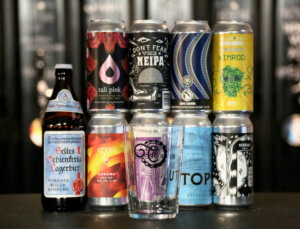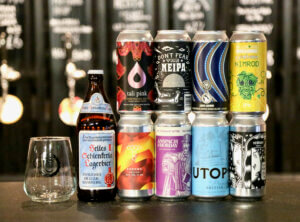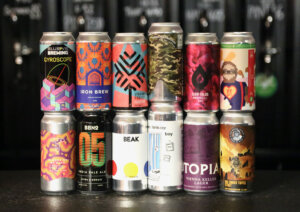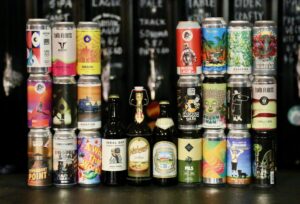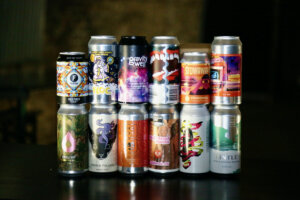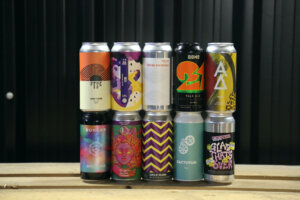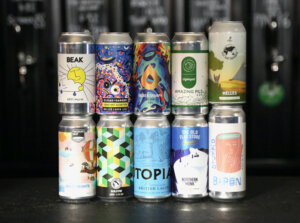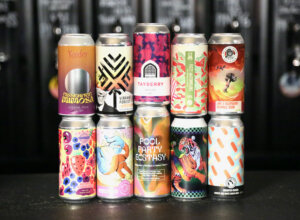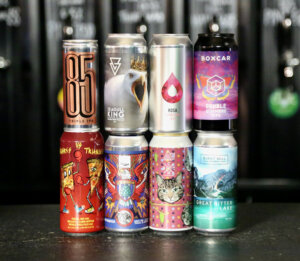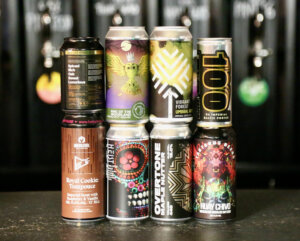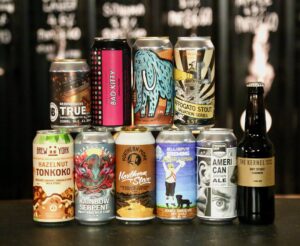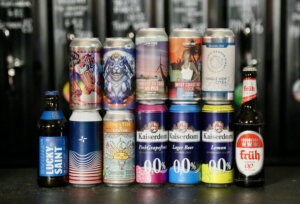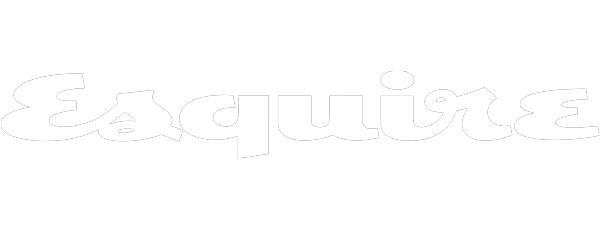I’ll admit, 18 months-or-so ago, I never bothered stocking more than one or two alcohol-free beers. It wasn’t because I was such a booze-hound that I thought them a waste of time not worthy of shelf-space, but because there simply weren’t enough to go at. Now they seem to be everywhere: the ‘AF’ sector is the fastest growing segment of the craft beer market. So what’s the best alcohol free beer?
While the alcohol-free beers of yesteryear were serviceable enough, choices were typically limited to the odd AF lager such as the (still excellent) Lucky Saint, or perhaps a nonplussed bartender’d offer you a sub-2% (and equally excellent) Kernel Table Beer with an apology and a shrug. Right now though, in my bars and via my website, I’m fortunate enough to proffer belting options from a new wave of low-alc specialist breweries intent on ripping up the rulebook.
Take Mash Gang as exhibit number one. I’d rate these guys as the leading light in modern alc-free brewing, simply because of the range they offer.
At the entry and ‘normal’ end of brewing they make Stoop, which is as good a lager as you’ll get. Other than a very slight lack of body this alcohol-free gem would pass for a beer punching 5+%. It’s a clean and bright American style pilsner that brewers deemed so good Mash Gang created a variant that aped the popular Japanese lagers ubiquitous in larger pub chains: Stoop Extra Dry Alcohol Free Japanese Pilsner. If you’re new to low- and no-alc beers then this fine pair is really where you should be starting out.
The wonderful thing about Mash Gang is they can deliver classy and crisp beers like the lagers just mentioned and also knock out some utterly bonkers stuff too. Once you’ve had your lovely lager, how’s about treating your taste buds to Mash Gang’s Sour Patch Hops – a beer crafted around the flavours of sour patch gums? Or the same brewery’s ‘Low Alcohol Milk & Cereal Pale Ale’ Cap’n Krunk? Made with vanilla and cinnamon, the latter is touted as a ‘breakfast beer for any time of the day’. It seems odd to picture slugging this alongside Sunday scrambled eggs but, given the absence of alcohol, it’s only society holding you back. As I said, Mash Gang brews range from the sublime to the ridiculous via the unashamedly experimental. Get in on these and wake up fuzz-free.
Another brewery really pushing the boundaries of the no/low category these days is Lowtide. Based in Bath, here you have the familiar tale of two friends setting up something new whence they tired of searching for a beer that simply didn’t exist (in this case, a head-turning no/low offering). Everything about Lowtide feels like they’re a ‘regular’ brewery. The branding is fun yet sharp and snuggles on shelves alongside the orthodox exquisitely. Plus, Lowtide beers all sound like something you’d expect to see in any respectable bottleshop. Yet dig a little deeper and you’ll struggle to find any booze at the bottom of these cans.
Now, I’m no scientist, but when I started to explore the latest wave of alc-free beers, I started to learn about the process a bit more. The big issue breweries in the sector grapple with is they typically create a boozy beer then remove the alcohol, often by heating their produce to temperatures that jeopardise flavour profiles. While removing booze is an ongoing issue, techniques have emerged to sidestep the hurdle, allowing brewers to concentrate on what they’re actually creating in the first place. And concentrating on what they’re creating is something Lowtide have mastered.
Like Mash Gang, Lowtide’s flagship lager is a cracker, but where these guys really excel is with hops. Something like the New England IPA Cosmic Turtle has a beautifully pillowy mouthfeel accompanied by a huge fruity aroma, all owed to the truckload of Citra and Mosaic hops Lowtide sling into it. Sky at Night, Lowtide’s AF porter, continues the trend: a cracking beer without the booze and full of rich chocolate, vanilla and coffee notes.
If it’s the traditional you’re looking for then rest assured: some big German breweries are in on the AF act as well. I would have thought they risked breaking The Reinheitsgebot – the country’s brewing purity law laid down in the 1500s which I’m fairly sure would frown at beer with no punch. Either way, it seems like the controversy is worth it for the likes of Kaiserdom and Andechs. Unsurprisingly neither stray far from the classics (perhaps the pair are heeding the Reinheitsgebot after all), which means we see a constant stream of Kaiserdom Grapefruit and Lager disappearing from our fridges, and customers in-store and online raving about a cracking Weissbier from Andresh.
Of course, more than a few drinkers tend to roll out the “what’s the point of a boozeless beer?” or “I’ll drink cola” lines whenever the topic of AF beer comes up. But clearly one of the great things that has come from the recent mini-revolution in low-alc brewing is you can actually get hold of beer when you really fancy a beer but are avoiding a ‘beer’ beer.
Today, you don’t have to force down a Kaliber when you’re the designated driver, or sink four pints of orange juice back to back. Better, beerier options exist. In a traditionally tricky time for independent breweries, it really helps to keep helping the little guy. And if you can do that while skipping the odd hangover?
That has to be good news, right?
Of all the weird and wonderful beer styles that come through the shutters of Craft Metropolis towers, there’s one that holds more authority and decadence than any other – the barrel-aged beer. But what is it, how is it made and why – despite an exhale-inducing price tag – is it so flipping sought after? Let me take you on a guide through the barrel-aged beast… and shine a light on some of the finest barrel-aged brewing in the craft beer world right now.
What is a barrel-aged beer?
A barrel-aged (BA) beer is quite simply a beer that’s been stored in an old barrel. Typically bourbon, whisk(e)y or wine, but in the crazy world of beer, pretty much any booze-laced old barrel will do – sometimes brewers use port, sherry or even brandy barrels to age their concoctions.
The eventually chosen barrel has of course stored a glorious liquid before, which means its inners have soaked up all the boozy goodness of a previous occupant. By shifting a recently fermented young beer into one of these old barrels and leaving it to ‘rest’ for a while, the process begins to reverse: the boozy flavours remnant in the barrel’s wood slowly seep into the encased beer, and the beer starts to change and evolve. It’s not just the booze in the barrels that starts to ooze into the beer either. The wood also plays a part, lacing the resting beer with notes of oak, cedar, redwood, or indeed whatever it is the barrel is made from. So you have a new beer with the potential to take on flavours from multiple, unique sources. Already you can imagine the myriad possibilities. The beer going in, the age of the barrel, the wood, the previous beverage… the outcomes are, speaking practically, limitless!
How does it work?
When the beer goes into the barrel it will initially take on some of the flavours of the previous liquid. That’s the first stage. Most barrel-aged beers also take on some base flavours from the wood quickly, which will generally fortify them with light vanilla and strong caramel notes too. Already sounding good, yeah?
From here the beer ferments further and it’s as this happens that the biggest flavours and transformations begin. All in all, barrel ageing takes a long time: it’s not uncommon to leave beer in a barrel for at least a year! The results, if you ask me, are usually worth it. Over time you can coax bigger flavours like roasted coffee and burnt toffee out of hiding, along with subtle coconut, roasted almonds and treacle – all depending on the wood and the previous inhabitant, of course.
Can you BA any beer style?
You can; any beer will age, but with wildly differing outcomes. If you try to barrel age, say, an IPA, or something with a similarly subtle flavour, the barrel’s much more grandiose flavours simply stomp all over the encased beer. The big flavours dominate to the point the IPA’s initial flavours are indetecatable. Barrel-ageing IPAs and such, then, is rarely worth the hassle. By contrast, the logical and most commonly BA beers are stouts. Stouts’ big, bold flavours and relative alcohol heft mean they stand up well to the barrels’ attempted bullying. They’re not trampled. They’re turbo-charged.
So just stouts then?
No. Belgian lambics are sour beers that have been brewed and barrel-aged since the 1200s! They lean on the barrel a bit to take the flavour from it but even more so for the brettanomyces. In the case of lambics, the microfauna in the wood start a spontaneous fermentation which creates a skin and spores on the top of the beer… all very geeky, and a bit gross to look at, but the process creates the face-melting goodness and wonderful sour tang that Belgian lambics are famous for.
Why do barrel-aged beers cost so much?
Obviously the barrel-ageing process requires patience and space, hence the hefty price tag of BA beers. Plus, because of the rarity and expense of the barrels in the first place, BA beers tend to be small batch in a world that is already very small batch. These are micro-batch in the scheme of things!
What are the best BA beers I can buy right now?
In terms of dark beers, I’m a huge fan of Nerdbrewing. A small brewery in Sweden, they make a world-famous barrel series and historically they’ve never failed to deliver. The Polish brewery Maltgarden is also a brewery to look out for. In fact, head Maltgarden brewer Łukasz Rokickieven recently dropped into our new venue in Brixton and treated patrons to a BA Maltgarden tasting – the genuine astonishment of those in attendance just proves how otherworldly BA stouts become.
With lambics, 3 Fonteinen are world-renowned. This brewery’s beers marry the classic Belgian sour taste with subtle funky flavours that make things much more approachable than you might otherwise expect. Elsewhere, Cantillon are a little further towards the nerd-end of the lambic scale. You’ll find Cantillon lambics at the top of most aficionados’ must-try lists.
Closer to home, you could do much worse than seek out a BA stout by Emperor’s brewing. Damien, who runs the cuckoo brewery, is heavily, bizarrely and brilliantly inspired by Star Wars, and ages some of the UK’s finest dark beers to perfection time and time again. Emperor’s brews are among the most highly sought-after, limited-release beers you’ll find in the UK. If you’re ever lucky enough to spot one, snap it up!
When an email dropped in my inbox from Anspach & Hobday telling me they were looking at making a dent in the Guinness market with a similar product I have to be honest I thought “good luck with that one!”A couple of years on and I am happy to concede I was very wrong and their porter – London Black – is flying out of taps all over the UK. For a small indie to achieve this is something special so I caught up with the A&H team to find out more about their unique beer. But is it the best Guinness alternative beer?
Oli:
Is it fair to say London Black has taken the UK by storm, or is that too bold a statement?
A&H:
Haha, maybe not quite but it’s been a storm for us! Our creation was designed as is a local challenge to Guinness. We knew it was a very bold thing to try, bordering on madness, but we backed ourselves and we couldn’t be happier with how it’s gone. In a relatively short time since it’s launch we now have nearly 200 fixed house lines nationwide, to the point where this beer is now taking over the brewery! It’s making up 67% of our brewing, even in the summer, so it keeps us very busy. The most amazing thing is that it’s bought us, as a brewery, a bit of security and sustainability in a time for the industry where those commodities are scarce. With the economic climate being what it is a lot of breweries looking at cutting back, desperately changing things or God forbid closing. What London Black’s popularity has meant for us is we can continue to operate and expand with a bit of a buffer as we know our new house porter is in so many pubs and bars.
Oli
How did it all come about?
A&H:
As a brewery known for dark beers this just felt like it was a natural progression for us, we just had to pick the right product and timing. We did some research and felt there was nothing out there to stand up as a genuine and deserved local alternative to Guinness so we set about creating a sessionable London porter. The key difference to most other porters is the introduction of nitro gas, which we felt this was the key way forward and a way to make a mark.
With it we were able to elevate the traditional and classic porter to a unique drinking experience that is accessible to both macro and micro beer lovers – and that’s been key – it’s drink for craft drinkers and nerds and your average punter too.
Oli
So what’s the science, this isn’t a regular tap beer is it?
A&H:
No, the nitro in the beer is part of what creates that smooth pour and settle most people associate with this style. The most noteworthy effect of the presence of nitrogen in the beer is the tiny, cascading bubbles that result in its distinctively smooth mouthfeel and tight, creamy head. Due to the low solubility of nitrogen in liquid, and the low level of CO2 in the gas mix, the actual level of gas in the beer is very low. As a result, the bubbles that form in the beer are much smaller than you would find in a typical beer. Furthermore, the lower gas level means that bubbles do not spontaneously form. Instead, they need to be ‘initiated’ and encouraged to form and this is the role played by the diffuser plate found in a creamer tap nozzle (a special nitro tap.) By forcing the beer through tiny holes in the plate of the tap the gas is broken out of solution forming the tiny bubbles that create the head. A significantly higher serving pressure is required to force the beer through the diffuser plate successfully; typically 35psi and using special mix of gas that stops the beer over carbonating and keeps the beautiful silky smooth texture. You did ask for the science, haha!
Oli
Did you realise what you’d created? It’s a genuinely new and groundbreaking bit of tech and stands up as a genuine alternative to the big boys, so what next for London Black?
A&H:
Obviously we hoped it would work and we knew there was a gap in the market but we couldn’t have imagined how well it’s turned out. We’re just really glad we had faith in it and backed the product hard from the start. The most amazing thing is when people try the beer and like it so much it makes up their mind for them; we back our beer to speak fo itself. The future looks great but needs some more work but it’s all heading in the right direction. We’re still a small company and a small brewery in the scheme of things so it’s tricky. Despite how well it’s taken off the brewery owners (Paul Anspach and Jack Hobday) still do most of the London installations for the new London Black lines and all of the marketing for it at the moment as that’s just how things are at a small brewery. Maybe autumn and winter this year will be key time for us getting someone in to help market London Black. We already have a great distribution network set up which we didn’t before, so we’re not relying on just us to sell the beer it’s out there in the wild up and down the land. No matter where this beer takes us we’re already immensely proud of it and think it’s a belting alternative pint of “The Black Stuff”!
It’s summer which means it’s beer festival season. Who doesn’t want endless taps of beer in one setting and a party atmosphere? But which are the best?
1) Independent Manchester Beer Convention (Indy Man Beer Con or IMBC)is often seen as the holy grail, the number 1 and the most prestigious beer festival in the UK, especially when it comes to the hazy side of things in the craft beer world.
Starting in 2012 the fest has grown into a genuine world class showcase for the best breweries from the UK and beyond and you have to be fast if you want a slice of the action as tickets sell out in record time often going within a few hours of going on sale.
IMBC came about through being inspired by the UK’s craft beer movement but was the founder frustration that beer festivals in their current form weren’t really representative of this exciting and dynamic part of the industry and led them to setting up the fest to be at the forefront of creative beer. Personally I think they’ve nailed it because as well as utterly amazing beer the whole vibe gives off a huge open-minded, inclusive and modern feel and the buzz throughout all the sessions is electric.
The setting itself is fitting of such a glorious get-together. Set within the stunning surrounds of the Grade II listed, architectural gem Victoria Baths, sunken down in a swimming pool, it just feels so strangely right for such a quirky and brilliant fest. Everywhere you look there’s an assortment of stained glass, glazed tiles and Edwardian nods to the past. IMBC brings together a very hop- forward and joose-focused beer extravaganza. In the UK it’s the hype-fest for hype beer nerds.
Best for: Hoppy beers & setting
Honourable Mention: Hop City Beer Festival
The Little Summer Beer Bash is a brewer-run, intimate beer festival co-hosted by Verdant, DEYA, and Left Handed Giant.
The inaugural meeting was in 2017 and the three breweries have rotated the hosting of it since.
The line up of breweries is really the one that makes this really shine. The foundations are set by three of the UK’s best breweries and thus the folk invited from the industry to pop along are also the best of the best as they invite the peers whom they most respect. It’s a winning formula.
2022 saw 34 breweries all pouring some of the freshest most exciting beer around. Burning Sky, Gipsy Hill, Track Brewing, Pressure Drop, BoxCar, Beak, St Mars Desert, Wylam, Burnt Mill, Polly’s… I could go on but it reads like a who’s who of the UK’s top top producers. Throw into the mix the international presence of Other Half, Finback, Põhjala and the like you can see why it’s one not to miss out on. The whole set-up feels very cosy and welcoming and, again because of the high level of the three hosts involved, no detail is skipped and the attention to delivering the best possible beer experience is admirable.
At the time of writing the venue has not been fixed for 2023 but whoever hosts be prepared for a cracking day and amazing beers.
Best for: Beer variety, brewery experience, food
3) Beak These Hills festival launched in 2022 and was a resounding success thanks to a multitude of factors. Being set outdoors on one of the rolling hills near the brewery in Lewes the “Party Field” is the perfect setting for drinking beer – as long as the weather holds! A 25 minute walk down a farmers lane you’d be forgiven for thinking you had taken a wrong turn if it wasn’t for scores of other wristband-wearing beer nuts making the pilgrimage with you. Once in the field a horseshoe of tents hide under their stopped awnings some of the best import sours, European hop monsters and international impy masters. Grab a beer and perch up on a hay bail and watch the clouds roll over the Sussex hills. Bliss.
The most wonderful thing about the festival is how brilliantly organic and natural it all felt despite probably being a nightmare and a mission of mammoth proportions to organise. On the face of it, a field, a bit of live music and food and beer from some of the worlds best; sounds easy right? Despite the efforts that must have gone it from the very small team at Beak the festival felt relaxed, organised and above all heaps of fun.
A bigger and more structured event is planned for this summer but hopefully that just means building on what they already have and more of the good stuff to retain it’s natural charm.
Best for: Festival vibes, international imports
It’s pretty hard keeping up with most trends these days. Should I be on TikTok, is oat milk the new coconut milk, and is reverse yoga even a thing? Craft beer is much the same. Sometimes it feels like you need a personal assistant just to keep tabs on all the new breweries popping up and the new beers said breweries are releasing into the foray. To help you stay sharp, in this piece, I analyse a few of the UK’s hottest new breweries. The knowledge you need to keep up with craft beer nerds lies within.
1) Sureshot
Blossoming from the wreckage of Covid, Sureshot Brewing was something brewer James Campbell always wanted to do – break free from making beer for other people and produce his own. A fairly bold and confident move when competition for tap and shelf space is at an all time high. James backed himself however, having worked as a head brewer at some of Manchester’s most respected independent breweries: James even boasted Cloudwater as one of his former employers.
After a decade of guiding others at the cutting edge of the craft beer world, James decided that it was time to go it alone. To begin with, he launched a set of beers centred around New World hops that announced Sureshot’s arrival.
The initial release was met with a somewhat muted reception. Solid beers for sure, and they didn’t hang about long. But the beers were perhaps lacking some pizazz. James was likely a victim of over-hype and expectation following a star-studded CV, and Sureshot beers have since improved. At the time of writing, Sureshot are finally starting to hit their stride.
CM rating 7/10
Best beer to date: Heavens to Murgatroyd Double IPA. Two classic hops (Citra & Simcoe) make this big old 8% Double IPA sing. A perfect example of where this brewery has got to and where it’s heading.
2) Azvex
Azvex is a fledgling brewery set up within the booming craft beer scene in Liverpool that, at the time of writing, is not yet even a year old. Already Azvex have an admirable rep. Which is saying something given their (lack of) age.
Admittedly, Azvex are one of the more controversial additions to the UK craft beer scene. Founder and figurehead Adam Henderson was one of the founders of Neon Raptor, a Nottingham-based brewery who had, when Covid hit, really started making some noise with their big, hoppy brews.
Lockdown gave Adam a chance to step back and take a breath away from the business after going at things non-stop since 2015. In doing so he started to move away from Neon Raptor altogether. There remains a clear period in history in which the quality of Neon’s hoppy output reduced and, at around the same time, Azvex was born. Sadly I have no insider info on what happened within Neon Raptor, and publicly all was so-say amicable, but the split felt a little like a bad breakup. If nothing else, it was somewhat sudden.
Things hardly became much smoother as Azvex emerged: immediately beef began with the brewery Alpha Delta, whose logo and image undoubtedly bore similarities to that of the new Liverpool-based outlet. Azvex’s nonchalance was bold, but the overriding feeling was Azvex backed themselves as a brewery and didn’t care much that they were rocking boats. Their arrival almost had a Brewdog vibe about it… back when that meant something good.
Overall, the Azvex inception seemed a little messy and strange. Their initial release, much like Sureshot’s, was good but not excellent: an OK and a pretty damn good IPA flanked a somewhat nondescript sour.
Azvex’s next set of beers, however, blew me away, and Azvex has remained at the very top ever since. Their hoppy beers have been off the charts. They’ve delivered huge stouts with mega flavours (obvious comparisons to Neon Raptor’s range were made). And more recently, Azvex nailed a sour that put to bed accusations of the brewery being “good but unable to pull off sours”.
The rate of Azvex’s output has also been impressive. Azvex delivers the goods with a frequency that makes the mouth water and the head spin. It’s testament to the brewery that it already feels like Azvex is up there with Polly’s, Verdant and the rest as one of the country’s best. Again, at the time of writing, this brewery is not yet a year old.
CM rating: 9.5/10.
Best beer to date: Lab Grown Diamonds was the benchmark for their IPAs so far.
3) Baron
Baron popped up from nowhere. One day our chief beer taster Charles (not his official title but pretty accurate!) said he’d had an amazing beer he’d picked up randomly as he’d not heard of its brewer (what a job!). Its brewer, on closer inspection, was an outlet simply called Baron. Our digging revealed Baron was run by someone called Jack on a tiny 1000L kit somewhere in Hertfordshire. I managed to get hold of a lager and a pale ale and tried them both. The lager was (to this day) one of the best I’ve had from a UK brewer and the pale wasn’t far behind. From then on we’ve stocked every brew (in both can and keg) that Baron has made and champion Jack and his wares whenever we can.
Jack says “Baron Brewing is a playground for beer… the next beer will be the best beer.” All we say is don’t leave it to chance: try what you can on the spot and don’t wait around. This is a brewery that’s going places.
CM rating 8/10
Best beer to date: Infinite Monkeys lager. One of the best I’ve had.
At this time of year lower ABV beers come into their own so as part of a look into innovation in craft beer I sat down with one of the UK’s most exiting no/low alcohol craft beer brewery Mash Gang to find out more about their 0% beers and how they make them. Here’s what the owner and brewer Jordan had to say…
Why did you start all this?
I just found a lot of alcohol-free beer off-putting, not because it was bad, or because it was boring – which it was – but it was the approach that sucked the most. The worst thing was there was a lot of the apologetic style marketing about the whole thing, all a bit cringe-inducing like everything seemed to be saying; “I’m sorry for making this product.”
The vibe was all about making the product passable if you’re driving or unable or unwilling to drink alcohol, but it just felt like it was compromising itself before even started. Not only did I think that was rather sad but also the range of beers leaned heavily towards just lager or, at best, pale ales and seemed scared of doing anything else. I wanted to make really weird alcohol-free beer inspired by breweries like on Omnipollo or Amundsen who were making pastry stouts and fruit sours with wedding cake or whatever thrown into it! I wanted to do that but keep it alcohol free.
That means you do make some pretty crazy stuff, is that still a challenge to get it accepted?
I still get asked: “what’s the difference between a heavily fruited sour and just a fizzy smoothie?” and while its frustrating but I don’t care any more. I’m here to make beverages and it doesn’t really matter whether it’s this or that, you know? I‘ll get a comments all the time where it’s, “I don’t know if it’s a beer at all.” Does it matter? I like it. Do you like it? Yeah? That’s good enough isn’t it? Sometimes you feel like it’s not and that’s weird to me.
Whats the science – how the heck is it done?
I literally can’t tell you. I’ve worked so hard on making this thing a reality there’s no secret inside info, sorry!
What I can tell you is when it comes to it removing all of the alcohol from a full ABV beer it is very expensive and time consuming as well as energy consuming. So we started looking at things like modified yeasts to create these beers to start with. These types of yeasts make very little alcohol from from the sugar in the brew but although it worked we found that those beers tasted sludgy or just sugary, so we started to design a new process that that was almost the reverse of making an imperial stout. We saw this over and over all the times when we’re around cuckoo breweries that work with a lot of Imperial stouts so we did just that – reverse it. Obviously there’s more to it but we wanted to make sure that everything we did worked. We were very vigilant and exacting but it seemed to click more times than it didn’t so we executed it until we were happy and then scaled it up.
Who is your audience, your target customer?
Anyone really. We didn’t just want to market to people who were sober or were trying to look for some kind of dietary hack like cutting calories or losing weight, that was never the idea. We wanted to market to people like us, we want to market to people who wanted to actually not drink less and be able to drink more! I also wanted to make sure that it was available in pubs and bars where you have to drive to. People are only are able to stay around and drink as long as the driver will stay. So if you give them a genuine craft beer experience where they can have four pints, then people are going to stay at the bar longer. It’s better for the bar and better for the customer. The time of going into a bar at lunchtime from your office sink three pints and coming back to work in the afternoon is for the most part over. I was doing that 10 years ago, I was having pints at lunch and the evening too. It’s not healthy or sustainable so we’re looking at helping anyone that still wants to enjoy beer but wants to regulate it better while still trying exciting beer.
What next for the brewery?
It’s no secret the overwhelming success and thirst for Mash Gang has left us having to learn fast and we’ve make mistakes along the way. We’re very open about it on our mailer to both customers and trade. Sometimes getting beer made on schedule, delivered to the right people and in one piece has failed for one reason or another. But you reset, learn, and keep moving forward. We have already improved as much as we’ve grown so we’re in a happy space.
As part of our expansion plan, we have taken the decision to restart production of kegs. We have never experienced a demand for draught beer at this level before so the timing is right. This means the phase moves from cans in hands to pints in pubs through the festive time and into 2024 until we are represented in a bar in every major and minor UK city. There’s even plans to crack America but one step at at time. Needless to say we’re excited for this year coming and appreciate every order every day, it’s still a thrill.
“Absolute madness and an impossible dream.” That’s the verdict one industry expert on the craft beer industry right now. With the aftermath of COVID lingering and the cost of living and materials at an all time high it’s easy to see why, sadly, this comment might ring true. However, some brave souls are still following their passion and trying to make a mark. Here are the some of best young craft breweries who are making brave steps to expand according to Oli the owner of Craft Metropolis.
Pretty Decent Brewing Co.
Pretty Decent is a very modest name for a very very good brewery. The first of their very decent beers was brewed back in 2017 but it’s only been since moving in 2021 to an arch in Forest Gate things really went up a notch. The extra space and the larger equipment made it much easier for the brewery to make a name for themselves and get beer into the hands of thirsty locals. It was a key move for them and it also allowed production to expand into bottle-shops and bars all over London and the UK. The beer flowed and the effect snowballed and another move followed in December 2022 when production relocated again to an even bigger facility in E17 and they joined the famous “Blackhorse Beer Mile.”
You can always spot a Pretty Decent beer by their rather quirkily titled beer names. How about a pint of; “I Reckon You’re Overthinking This Robbie Williams Track” or a half of; “Our Illustrator Went On Jury Service And All We Got Was This Label”!? If you’re still not sold let me throw in the fact that owner and former charity worker James Casey donates 15p out of every pint sold to charity. Pretty Decent if you ask me.
Gravity Well
Gravity Well’s journey is almost a replica of Pretty Decent and their journey is as equally encouraging. Founded after a hobby got out of hand the inspiration behind it is that beer is; “a gravitational force that pulls people together,” and a strong space theme runs through all their beer names and imagery.
They too started in an arch, expanded into another next door, and now find themselves on a bigger industrial estate with beery neighbours Redemption and Signature in Tottenham.
Before the expansion their beer was criminally good but nearly impossible to get hold of. They were like some mythical beast of the London brewing scene and simply spotting their brews on tap was like some kind of rare discovery that needed documenting so people would believe you. Thankfully the beer quality remains just as good now they have expanded their reach and have started to pop up in much more locations. There’s something about their beer that’s just different which I can’t really nail down or explain. Although they are unashamedly very much into “a real love for hazy IPAs” each and every one tastes like it has an edge that sets them apart from other breweries. One theory of mine is the water they use. They still use a reverse osmosis filter to purify mains water which is both time consuming and tricky but maybe gives them the signature flavours. One of their latest DIPA’s Hubble Bubble showcases this with a smoothness and tang to it that I’ve not really encountered anywhere else. On a more sessionable end of things their 5-6% pales are a joy to drink so do seek out the all-year-round Galaxies Apart as a starting point for a voyage of discovery.
Makemake
This brilliant Portsmouth based up-and-coming brewery don’t tend to follow the norm. For example you pronounce their name like the Dwarf planet in the Kuiper Belt. For the uneducated like me it’s; Mak-ay mak-ay. The small outfit began their journey due to a “lack of access to the beer we desperately wanted to drink, especially locally, and since day one our focus has been on making what we enjoy.” I’d say they’ve achieved that goal and then some.
They blend traditional European techniques with the more aggressive and experimental practices of American breweries to create an epic range of styles from light and zippy session IPA’s right up to huge coffee and chocolate-laden imperial stouts. That said, it’s their sour IPA game that really flourishes with the blend of old and new brewing techniques colliding to spawn some really exceptional flavours. From basement home-brewing in 2017 to building a brewery in 2022 it’s not been an easy ride but the arrival of DEYA brewing’s old kit and canning line has catapulted production and sales. A newly added taproom was installed at the end of last summer and they seem that there will be no let up in exceptional and quirky brews coming out of the tanks.
An endless cosmic arena of possibilities await for these guys and all small breweries out there right now.
It’s a tough time in the industry but long may innovation and passion keep inspiring people to keep making interesting and independent beer.
It’s a little after office hours and I’m in a queue at, of all places, a bar.
‘What can I get you?’ asks the bartender as I make it to the front. He’s wearing a baseball cap and wire-rimmed glasses, and he dons the obligatory modern-beer-moustache. He’s smiling, enthusiastic and immediately likeable.
‘I’ll have a half of that Burnt Mill West Coast IPA please.’
‘This one?’ He gestures to the only West Coast IPA pouring from the bar’s ten taps. ‘You could definitely try this. But if you’re after an IPA, I’d go with this.’ He gestures again. ‘For my money, this is the best IPA we’re pouring right now.’
I glance in the direction of what he’s suggesting. It is an IPA. But it’s a New England IPA, as opposed to the West Coast IPA I was after, and I hesitate.
Should my fellow bartender really be suggesting I try a different beer?
Fairly regularly, curious patrons that drop into one of the Craft Metropolis taprooms down in South London ask me about the differences between West Coast and New England IPAs. Their enquiries are perfectly valid. They’re about beer, after all, and any question about beer is a good one. Plus, the IPA is a pretty niche beer style in itself. So can its various sub-styles really be that different?
The surprising answer is yes: West Coast IPAs and New England IPAs are now so dissimilar it’s probably time we started to think about a less confusing naming convention.
The West Coast IPA came along first, and was probably the beer style initially responsible for craft beer’s worldwide explosion. The history books suggest the style was born over on the USA’s west coast, back when experimental homebrewers began adding unprecedented hop volumes to their brews in search of ever greater depths of flavour. Compared to the New England IPA – or NEIPA, as it’s become known – the West Coast IPA (WCIPA) was early stage experimentation. West Coast IPAs then and now were and remain relatively bitter (thanks to the hops), and any sweet notes derived from the style’s malted barley are deliberately downplayed. In West Coast IPAs, the hops shine, which results in uninitiated drinkers invariably scrunching their faces post sip before describing WCIPAs as ‘too hoppy’. What such drinkers usually mean is the WCIPA’s distinct bitterness is unexpected. And it’s unexpected because, these days, the beer drinkers’ drink of choice is invariably the NEIPA.
New England IPAs are sometimes known as East Coast IPAs – which pinpoints their birthplace as that of the US East Coast. Whether deliberately or otherwise, the NEIPA is often positioned as a reaction to the WCIPA – the two styles contrast in looks, in aroma and in taste.
West Coast IPAs – which usually sit on a backbone of malted barley – are typically amber in colour and transparent in nature. New England IPAs? Their colour profiles vary, but they often lean towards yellow. Undeniably more striking is the fact they’re opaque (or ‘hazy’), which is the result of the NEIPA’s malt profile. Typically, brewers use a combination of barley, wheat and/or oats in their NEIPAs’ malt bills, which make NEIPAs soft and creamy – a characteristic that’s proving increasingly popular.
You can expect both West Coast and New England IPAs to carry fruity aromas… but the overlap is rarely sizeable. From a West Coast IPA you might detect some citrus, but it’ll invariably be cloaked by powerful aromas of some form of foliage – pine is the go to and fresh cut grass is another favourite. Increasingly, notes of ‘dank’ cannabis waft from the WCIPA’s glass.
By contrast, any New England IPA that doesn’t smell like a tropical fruit punch should be treated with suspicion. In a New England IPA, I’m looking for stuff like mango, passionfruit, papaya and cantaloupe melon, and maybe even a sprinkle of coconut (depending on the hops on showcase). And while it’s possible for a beer’s aromas to differ from its flavours, in my experience, such discrepancies are rare.
We’ve already touched on the differences in flavour but to spell it out: West Coast IPAs are usually bright, piney and resinous, possibly sweaty, sometimes fruity and, of course, their biting bitterness lingers. By contrast, New England IPAs tend to be so laden with fruit they’re described as ‘juicy’. NEIPAs are usually tropical and most likely to be a little sweet, with very little bitterness. Oats and wheat, when used, give NEIPAs a creamy quality.
The two styles are both outstanding, and just as I love stouts, saisons, lambics, goses, lagers, pales and porters, I adore both WCIPAs and NEIPAs in turn.
Still, they’re not the same thing, and sometimes you know precisely what you want.
I think about all the above back at the bar, where the (increasingly delightful) bartender is gesturing towards his favoured NEIPA, still with a big grin on his face, hoping to convince me to go with his suggestion.
‘You know what?’ I say. ‘Give me a half of the West Coast and a half of the New England.’
He’s even more delighted than he might otherwise have been, and as I take the two halves back to a table, so am I.
Craft beer. It’s all about experimentation but is West Coast the best coast? Only you can decide….
Verdant Brewing Co – Even Sharks Need Water NEIPA
Cornwall’s Verdant is seen as one of the UK’s best craft breweries, and Even Sharks Need Water is one of the brewery’s regular gems. Fruity, juicy and tropical; thick, creamy and soft. A great example of a solid New England IPA.
Pressure Drop Brewery – Behind Door Number 3 NEDIPA
Pressure Drop are no strangers to supplying drinkers with juice, and in Behind Door Number 3 they amp up the NEIPA to Double IPA territory. Soft, fruity, tropical and strong. This isn’t the thickest beer, but it packs a punch.
Verdant Brewing Co – Remembering Things I Didn’t Do WCIPA
The periodically rebrewed Remembering Things I Didn’t Do shows what Verdant can do when armed with west coast hops. This is citrusy and bright, clean and bitter. Dank notes complete the West Coast ensemble.
Burnt Mill Brewery – Get The Onyx WCIPA
Underrated all-rounders Burnt Mill flex their West Coast might with this clean and crisp WCIPA. Expect piney bitterness with hints of passionfruit. Warning: this thing reeks of weed.
For the most part, I’m pretty happy to pretend that Craft Metropolis – the online beer shop and taproom I run down in South London –is the only craft beer shop in the world.
Occasionally though, I find myself somewhere from which grabbing a beer from HQ would prove problematic. Like when I’m visiting family up north, for example. Or when I’ve taken a flight with a budget airline whose luggage allowance completely disregards how heavy beer can be.
In such instances, I’m always happy to support other independent beer shops. After all, beer shops are almost always staffed by friendly people, and I know from first-hand experience how difficult running an independent beer shop can be.
So recently, caught short about 15 miles from HQ, I darted into an independent taproom to see what I could find.
When I opened the door to eight beers on keg, my face bunched into a beam my moustache couldn’t hide. I was a beer shop owner in a beer shop, chomping at the bit to get stuck in.
I gravitated towards the bar, taking in exactly what it was I was about to work my way through. But as I did, a twinge of disappointment set in.
The eight taps before me were serviced by a lager, a pilsner, a radler and a pale… plus four different kinds of IPA.
Veteran beer fans might have spotted the problem with the above.
Lager and pilsner are very similar styles. The radler is the same thing paired with lemonade. Then you’ve got the pale and four – four!– lines of IPA.
Now, don’t get me wrong. I adore hop-forward beer. I respect its role in steering curious drinkers away from Bud Light.
But I like beer in all its other forms too! Stouts, bitters, porter; sours and experiments are glorious.
For me, the existence of a taproom with such a stripped back selection suggests, somewhere, something’s gone wrong.
In truth, situations like the above have probably been threatening for a while. For years, both beer drinkers and brewers have harboured an unhealthy fixation on a narrow range of styles.
West Coast hoppy beers began the trend. For a long time, alongside lager, they were the champions of taprooms worldwide. But their characteristic bitterness was always something some drinkers disliked… which meant taprooms always offered exciting alternatives.
If there has been a turning point, it was probably shortly after the birth of the New England IPA.
New England IPAs forego bitterness in favour of sweet notes. They’re smooth and they’re creamy. And they’re typically full of luscious and juicy notes of tropical fruit.
Frankly, they’re outstanding.
Which may well be the problem.
Following the rise of the New England IPA, has a certain style of beer become just too good?
The chances are I’m overreacting. After all, although hoppy beers continue to dominate beer shop line ups, few taprooms today offer no darks nor sours whatsoever. Until recently, doing so made little business sense.
Still, the fact that it’s now viable to run a taproom absent of variety is concerning.
And consider our current government’s recent beer duty ‘cut’.
The cut, at least when announced, only applied to beer sold in containers of 40 litres or more (at the time of writing, this is being reconsidered following a backlash). The idea, some say, was to skew the playing field in favour of ‘big beer’: big breweries sell beer in great quantities, while craft breweries tend to sell beer in 20 or 30 litre batches.
Whether or not it was a deliberately nepotistic move is the subject for another day. More relevant for the time being is, if the plans go ahead, brewers now have a further financial incentive to brew more of their popular lines and less of their small batch stuff… presumably making things even more homogenous than they already are.
Back in the taproom, chatting with the bartender and trying one or two of the beers, I raise my contention.
It’s a relatively hop-focused lineup, I say. And he understands what I’m referring to.
‘It is usually more varied,’ he notes. ‘We usually have…’ he turns to look at the line up. ‘Well, we usually have at least one sour on.’
For a second I consider asking why just the one – or where the sour is today, but I decide against it.
Instead, I choose which of the IPAs I want to drink first (Lonely Town by Howling Hops. A gem both tropical and resinous.), then I find myself a table and begin formulating the ending of this column.
Hoppy beers are fantastic, but what if they were just the beginning?
Experiment and explore and you’ll very much be rewarded. If you’re curious, here are one or two pointers to get you started…
Black IPAs are a great second step in beer exploration, because they pair lovely juicy hops with dark, roasted malts. Think of a beer that’s like a dark chocolate fruit & nut. Seek out Brick / Neon Raptor’s Black Light Black IPA or Wander Beyond’s Pod Impy Black IPA.
Biscuity, malty bitters tend to be popular in autumn, but there’s really no reason not to enjoy one as spring fades. Try Burnt Mill / Kyoto’s Other Worlds Extra Special Japanese Bitter or Yonder’s Boogie Modern Bitter for a modern version.
They’re potent but great. Think chewy caramels and toffees. DEYA / Boxcar’s Crocodile King Barley Wine was great. North Brew Co’s Good Things x North Barley Wine is a winner.
Roasty and toasty. Fans of coffee, take note. You can usually get hold of Pressure Drop’s Fashion London Porter. If you’re lucky, Kees Brewery’s Export Porter 1750 may be around.
Can be down-the-line or wild, wacky and wonderful. Look to Kernel’s Imperial Brown Stout London 1856 for the former and Amundsen’s Cherry & Chocolate Ganache Barrel Aged Dessert in a Can for the fun.
Different strands exist, but this isn’t a science lesson. Seek out Vault City’s Farm to Fermenter range. Brew York’s Le Mon Le Mon Imperial Lemon Sherbet Sour is fun.
Lager is the biggest selling style of beer in the UK so I sat down with lager specialist and Lost and Grounded co-founder Alex Troncoso as part of my look into innovation in craft beer to see where it sits in the independent scene.
– Your Keller Pils has become a huge success, was becoming a specialist lager maker the intention from the start?
Sometimes great things happen by accident, but Keller Pils was very much intentional. When we set out to create the brewery we decided we would focus on this somewhat obscure lager style as we needed a clear reason to exist – there would be no point to try to compete with the dozens of other filtered lagers on the market.
Starting with the end in mind – making an amazing lager – we then set out to design the best possible brewery we could knowing what we would need: we installed a mill so we could have flexibility in malt supply (currently we use Dingemans from Belgium), we knew we would need a mash tun where we could do various temperature rests or decoctions, and a very efficient boiling system to produce very clean and pale wort. But a key aspect of our lager brewing is how to deal with the alkaline water of Bristol which is definitely not ideal for brewing… to over come this we installed a biological acidification plant (lactic acid plant) which is the traditional German method of dealing with alkaline water. In this system we have lactic acid bacteria isolated from the husk of malt which is continually producing natural acid for us – we use this acid to adjust the pH of all of our beers during boiling.
So making lager was 100% the focus when we set up the brewery – this has taken a lot of dedication and a clear long-term vision as ultimately we have needed roughly double the tanks if we were to only make pale ale for instance.
– Why lager? Do you just love the style?
It was a bit of an evolution which happened over my career. When I started in brewing all I wanted to make was Pale Ale, and I had an amazing 8 years with Little Creatures in Australia where that was our focus. However, over the years I started to become obsessed with how to make the most simple of beer styles – lager.
From Little Creatures we moved to London where I took up the position of Brewing Director with Camden Town Brewery, which was a decision based on wanting to immerse myself in lager production. I spent a lot of time in Germany and Belgium, and slowly but surely I became increasingly fascinated by the world of lager.
And then along came Keller Pils…
– Tell us a bit about lager we might not know…
I think that lager is largely misunderstood in that it is really a technique and philosophy, it’s not just a matter of putting a specific yeast into some wort and it pops out as lager.
Amazing lager comes down to numerous choices – water treatment (incl our acidification plant), mashing, lautering and boiling regimes, wort cooling temperature (we go quite cold at 8C), yeast strain, fermentation and maturation profile, and lastly it’s about time – traditional, high-quality lager is a cold process and it takes time; we typically make Keller Pils in 4-5 weeks. Amazing lager also takes good production rhythm to keep the yeast happy – so much of quality really comes down to the yeast and how it is performing – it can be really difficult to produce great lager on a sporadic basis.
– How much of the business is making lager, your core beer?
Making core lager is the vast majority of what we do. Keller Pils and Helles comprise 80% of our volume. As we have 12 x 150HL lager tanks we always keep an eye on batches and it is amazing to taste Keller Pils at 2, 3 and 4 weeks and realise how much the lagering process improves the product.
– Lager has had a bad rep in the UK in the past, that’s changed right?
Ha, we wish! There is definitely more accounts that are interested in stocking amazing lager, but there is still quite a battle to be won against the bigger, well-established brands with large advertising budgets.
– Keller is thought to be the best UK indie lager, how’s that feel?
It’s feels amazing to have the recognition after setting out on what many thought was a crazy business plan, but we got there… it wasn’t easy! Our recent World Beer Cup Gold award for Keller Pils in Nashville, USA was a particularly sweet moment: the WBC is the largest competition in the world and the the judging is very rigorous – to have Keller Pils beat nearly 90 other kellerbiers from around the world was a great feeling.
– What’s it’s success?
Good question… we often talk about this and I think whilst it is refined and balanced, there is a certain boldness about it when compared to other lagers. It’s lemony and zingy, 30IBUs and definitely has a house “Lost and Grounded” character to it which stems from the raft of choices we’ve made along the way. We find once people are Keller Pils fans they seem to remain on the journey.
– Did you use anyone or anything as a base or for inspiration?
The inspiration for Keller Pils came from a trip to the hop harvest in Tettnang – I had a Kellerpils from a local brewery and had a lightbulb moment: what if we made a simple lager, unfiltered, using only traditional hops and make that our focus. Over the years little has changed in terms of recipe – still the same hops, although the base Pils malt can change from season to season. All we’ve done is gotten better at it over the years.
A little bit of inside info: the lake on the Keller Pils label is actually inspired by Lake Constance with the hop fields of Tettnang in the background
– If you’re not drinking your own lager what lager do you drink?
German lager is my favourite genre due to the clean nature – I love the classics like Augustiner and Tegernseer through to the bitter Jever – so good! On a recent trip to Berlin Weihenstephaner Helles was the beer of the trip – faultless and such a pleasure to drink.
– Who else in the industry inspires you?
For both Annie and I we love to see breweries that have a clear philosophy. Burning Sky would have to be one of our heroes as Mark and the team are very humble, make amazing beers, and have always done things their own way. The dedication shows.
– Any grand plans for 2024?
Ha, take some time off? But on the brewery front we will be installing a new keg line to keep up with demand – in summer 2023 it was tough to meet demand, so the team is looking forward to being able to keg faster, empty tanks quicker, and especially looking forward to having a new whiz-bang keg lifter as manually handling over 300 kegs a day takes it’s toll on the crew!
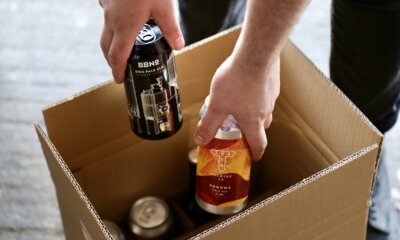 Step 1
Step 1
We trawl the globe tasting great beer
